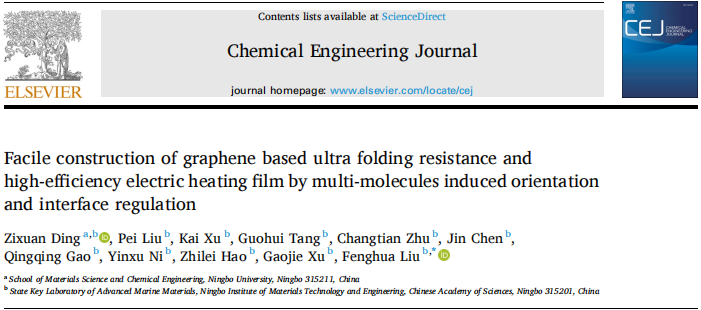
Recently, the team led by Liu Fenghua at the Ningbo Institute of Materials Technology and Engineering, Chinese Academy of Sciences, respectively selected curcumin (CU) and carboxymethyl cellulose (CMC) as the dispersant and binder. These, in synergy with SiO2 nanoparticles, induced graphene orientation and interface regulation, thereby constructing a highly flexible electrothermal film. CU contains hydroxyl groups, which enable strong hydrogen bonding interactions between molecules, enhancing the interfacial compatibility of the graphene slurry and reducing graphene agglomeration. SiO2 nanoparticles can be firmly anchored to the surface of graphene sheets through hydrogen bonding interactions, effectively preventing graphene aggregation. CMC exhibits multiple bonding modes with graphene (Gr), promoting film diffusion and significantly improving flexibility. During hydrolysis, CMC releases Na+, further stabilizing the dispersion of graphene. Additionally, an innovative film-forming process—suspension coating and casting—was employed to produce a large-area, ultra-flexible graphene electrothermal film (HF-Gr/CMC). This process is simple and feasible, requiring no heat treatment, thus significantly reducing production costs while offering potential for large-scale production. The resulting film demonstrates exceptional durability, capable of withstanding 50,000 folds at 180 degrees while maintaining stable performance, far exceeding the folding resistance values reported for other graphene-based composite electrothermal films. Moreover, the film exhibits uniform heating temperature distribution, a thermal radiation efficiency of up to 90.2%, and a thermal conductivity of up to 83.76 W/mK. These properties provide a feasible solution for the continuous improvement and development of graphene electrothermal films.
The research findings were published in the journal Chemical Engineering Journal under the title "Facile construction of graphene based ultra folding resistance and high-efficiency electric heating film by multi-molecules induced orientation and interface regulation."

Source: https://mp.weixin.qq.com/s/zIiqDfW9fAOrzO1hf8C4Uw


